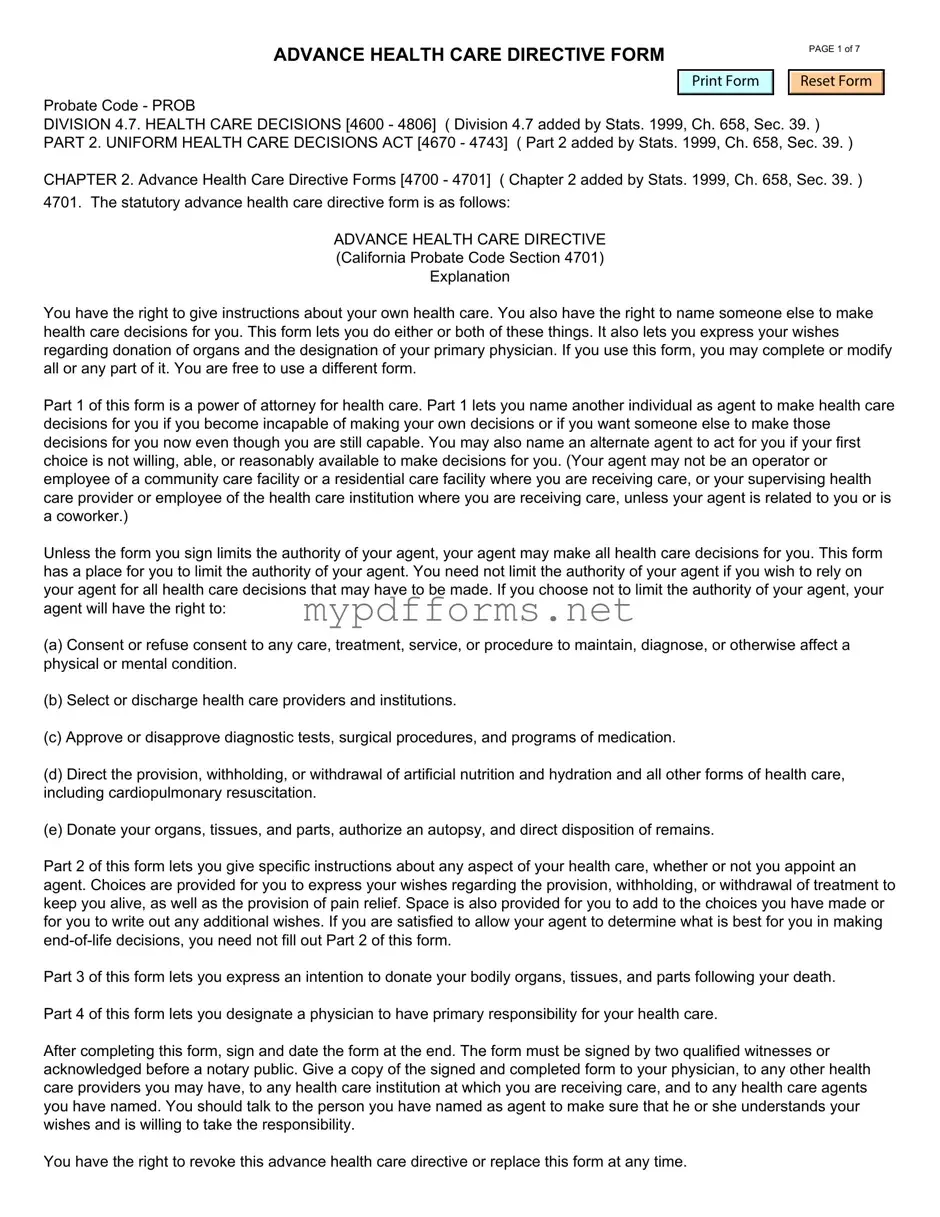The California Advanced Health Care Directive (AHCD) shares similarities with the Durable Power of Attorney for Health Care. Both documents allow individuals to appoint someone to make health care decisions on their behalf if they become unable to do so. While the AHCD combines both the appointment of a health care agent and specific health care wishes, the Durable Power of Attorney focuses primarily on the appointment aspect, granting authority to the agent to make medical decisions consistent with the principal's wishes.
Another document comparable to the AHCD is the Living Will. A Living Will outlines an individual's preferences regarding medical treatment in situations where they are terminally ill or in a persistent vegetative state. Similar to the AHCD, it provides guidance to health care providers and family members about the individual’s desires concerning life-sustaining treatments, although it does not designate a health care agent.
The Medical Power of Attorney is also akin to the AHCD. This document empowers a designated individual to make medical decisions on behalf of the person if they are incapacitated. While the Medical Power of Attorney primarily focuses on decision-making authority, the AHCD includes both this authority and the individual's specific health care wishes, making it a more comprehensive option.
The Do Not Resuscitate (DNR) order is another document that relates to the AHCD. A DNR order instructs medical personnel not to perform CPR if a person's heart stops beating or if they stop breathing. While the AHCD encompasses a broader range of health care decisions and preferences, a DNR specifically addresses resuscitation efforts, allowing individuals to express their wishes regarding this critical aspect of care.
Similar to the AHCD, the Physician Orders for Life-Sustaining Treatment (POLST) form provides specific medical orders regarding an individual’s preferences for life-sustaining treatments. POLST is designed for individuals with serious illnesses or those nearing the end of life. It translates the person's wishes into actionable medical orders, while the AHCD serves more as a guiding document that can be interpreted by health care agents and providers.
The Health Care Proxy is another document that mirrors the functions of the AHCD. This legal document allows individuals to appoint someone to make health care decisions for them when they are unable to do so. While the Health Care Proxy focuses on the appointment of a decision-maker, the AHCD also includes specific instructions about treatment preferences, making it a more detailed choice for individuals seeking to outline their health care wishes.
The Statement of Wishes is similar to the AHCD in that it allows individuals to express their preferences regarding medical treatment. However, unlike the AHCD, which appoints a health care agent, a Statement of Wishes serves more as a personal expression of values and treatment preferences, often without legal authority. It can complement the AHCD by providing additional context for health care decisions.
The Advance Directive is a broader term that encompasses various documents, including the AHCD. An Advance Directive allows individuals to communicate their health care preferences and appoint decision-makers. The AHCD is a specific type of Advance Directive that combines both the appointment of an agent and detailed instructions regarding medical treatment, making it a more comprehensive option for individuals.
For those exploring the various legal documents related to health care decision-making, understanding the Illinois General Power of Attorney form can be crucial. This form empowers an individual, referred to as the principal, to appoint an agent to handle their personal, financial, or medical affairs. To navigate the requirements effectively, prospective users may want to refer to comprehensive resources, such as those found at Illinois Forms, which offer detailed guidance on the process.
The Mental Health Advance Directive is another document that is similar to the AHCD but focuses specifically on mental health treatment preferences. It allows individuals to outline their wishes regarding mental health care and appoint a representative to make decisions on their behalf. While the AHCD addresses overall health care, the Mental Health Advance Directive hones in on mental health issues, providing a tailored approach for those with specific concerns.
Lastly, the Organ Donation Consent form shares some similarities with the AHCD in that it allows individuals to express their wishes regarding organ donation. While the AHCD focuses on health care decisions and appointing a health care agent, the Organ Donation Consent form specifically addresses the individual's preferences for organ donation, ensuring that their wishes are respected in the event of death.
